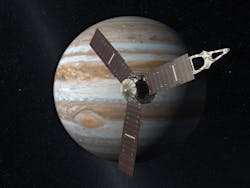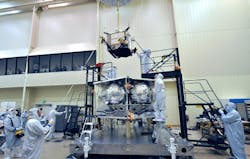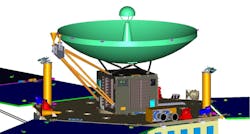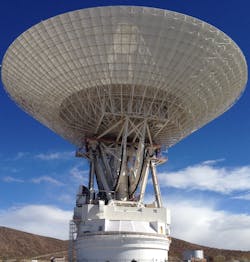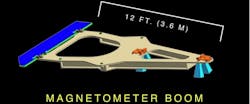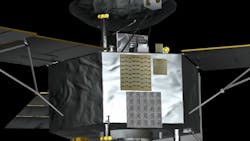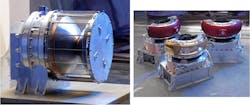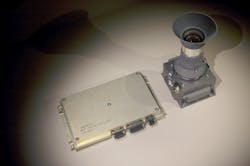In August of 2011, NASA launched Jupiter Near-Polar Orbiter, commonly known as Juno, embarking on a five-year journey to Jupiter. Now, Juno is less than a month away from exploring beneath the gas giant’s stormy atmosphere. It’s expected that findings made by the craft will help determine or open the door to explanations on the planet’s origins, which date back to the infancy of our solar system.
On the 4th of July, Juno will begin a 35-minute burn of its main engine before entering Jupiter’s polar orbit. Over the course of 20 months, the payload will pass by Jupiter’s north and south poles 37 times, completing each orbit every 14 days. Juno will skim Jupiter’s atmosphere up to 3,100 miles above its cloud tops, rotating three times per minute to get a full view.
In that time, Juno will create a 3D map of Jupiter’s colossal magnetosphere (denoted by white lines, Fig. 2), which is 20,000 times stronger than that of the Earth and the cause of Jupiter’s intense radiation band. Juno will also create a detailed map of Jupiter’s gravitational field to finally determine Jupiter’s mass distribution and core makeup.
In addition, high-resolution spectral cameras paired with telescopes will capture images of Jupiter’s underlying clouds, while spectrometers and particle detectors will analyze the plasmas that generate Jupiter’s powerful auroras at its poles.
Juno’s Solar Panels
Juno requires 18,000 solar cells to gather enough energy for its journey—508 million miles from the sun. In January, Juno broke the record as the first solar-powered spacecraft to fly further than 493 million miles from the sun. During Jovian orbit, Juno will run at a mere 405 watts.
Juno’s Radiation Vault
During its polar orbit, Juno will repeatedly pass through the intense radiation belt that surrounds Jupiter’s equator (denoted by orange ring and orange trail, Fig. 2), charged by ions and particles from Jupiter’s atmosphere and moons suspended in Juno’s colossal magnetic field. The belt, which measures 1,000 times the human toxicity level, has a radio frequency that can be detected from Earth and extends into earth’s orbit. Therefore, most of Juno’s electronics are contained in a six-sided titanium radiation vault. Exposed electronics may be made of tantalum and tungsten to reduce damage, or be encased in mini-vaults adopted from Martian explorers. The technology used to create Juno’s radiation vault for radiation- and heat-resistant electronics will benefit other spacecraft in future space missions.
The rest of this article reviews the nine technologies that Juno will use to probe Jupiter.
Mapping the Gravitational Field Determines Internal Structure
Gravity Science Experiment
Using advanced gravity science tools (the dish on top of the radiation vault, Fig. 4), Juno will create a detailed map of Jupiter’s gravitational field to infer Jupiter’s mass distribution and internal structure. Any perturbations from orbiting bodies, such as its Galilean moons, will be recorded as well. Juno will continually receive X-band (microwave) and Ka-band (radio) signals from a Deep Space Network (DSN) transceiver in Goldstone, California. As Juno changes its position and proximity to the planet during orbit, it will mirror these signals back to the transceiver, which will measure Doppler shifts in the transmission caused by Jupiter’s gravitational pull.
At Goldstone, the signals will be calibrated to account for distortion by the Earth’s atmosphere so that a detailed map may be generated after several orbits. The radio and microwave signals will be transmitted with limited interruptions from solar wind, the asteroid belt, and Jupiter’s ionosphere.
Mapping out the Magnetosphere
Vector Magnetometer (MAG)
Juno’s next mission is to map out Jupiter’s massive magnetic field, which extends approximately 2 million miles toward the sun, shielding Jupiter from solar flare. It also tails out for more than 600 million miles in solar orbit. The dynamo is more than 20,000 times greater than that of the Earth; it is thought to be caused by liquid metallic hydrogen that flows and conducts electricity in Jupiter’s outer core at pressures as high as 3 million bar.
However, to confirm the origin of the magnetosphere, NASA awaits data from Juno. Learning about the magnetosphere will also tell more about Jupiter’s radiation belt and plasmas made up of trapped ions and charged particles in the magnetosphere. These are responsible for continuous aurora at Jupiter’s poles.
Exploring the Deep Atmosphere and Water Content
Microwave Radiometers
Next, microwave radiometers (MWR) will directly detect six microwave and radio frequencies generated by the atmosphere's thermal emissions. This will aid in determining the depths of various cloud forms. It will sense concentrations of volatiles including oxygen, nitrogen, sulfur, and water vapor in Jupiter’s underlying clouds, sounding the atmosphere as deep as 1000-bar pressure, and detecting frequencies between 600 MHz and 22 GHz. By determining levels of these volatiles deep within the atmosphere, scientists will be able to gain further insight about Jupiter’s formation at the infancy of our solar system. Antennae on Juno’s MWR are built by the California Institute of Technology’s Jet Propulsion Lab.
Detailed Mapping of Aurora Borealis and Plasma Content
As Juno passes Jupiter’s poles, cameras will capture high-resolution images of aurora borealis, and particle detectors will analyze the plasmas responsible for them. Not only are Jupiter’s auroras much larger those of the Earth, they are also more frequent because they are created by atmospheric plasma rather than solar flare.
JEDI Measures High-Energy Particles
Three Jupiter energetic particle detector instruments (JEDI) will measure the angular distribution of high-energy particles as they interact with Jupiter’s upper atmospheres and inner magnetospheres to contribute to Jupiter’s northern and southern lights.
The JEDI will measure the energy of electrons at 25 kiloelectron volts (keV) to 1 megaelectron volt (MeV), along with the energy and species of ions from 30 to 1,000,000 keV. Each JEDI contains all necessary hardware to function independently of the spacecraft. They are arranged inside the electronics vault to analyze incoming particles from all angles of the spacecraft as it spins, processing over 30,000 events per second.
JADE Measures Low-Energy Particles
JADE, the Jovian Auroral Distributions Experiment, works in conjunction with JEDI to measure the angular distribution of lower-energy electrons and ions ranging from 0 to 30 electron volts (eV). Like JEDI, it analyzes particular interactions with the magnetosphere and the atmosphere to determine the mechanisms behind Jupiter’s auroras.
Waves Measures Plasma Movement
The radio/plasma wave experiment, called “Waves,” will be used to measure the radio frequencies (50 Hz to 40 MHz) generated by the plasma in the magnetosphere. Waves includes a sensor that measures the electric field of radio waves, and another that measures the magnetic component. It includes two field-programmable gate arrays (FPGAs): one executes commands and manages data outputs; the other carries out Fourier transforms and signal processing to translate analog signals to digital ones, as well as performs spectrum analysis and noise cancellation.
UVS and JIRAM Capture Various Spectra of Northern/Southern Lights
By capturing wavelengths of 70 to 205 nm, an ultraviolet imager/spectrometer (UVS) will generate images of the auroras’ UV spectrum to view the auroras during the Jovian day.
In addition, the Jovian InfraRed Auroral Mapper (JIRAM) leverages an infrared camera and spectrometer to map out the auroras’ infrared spectrum. JIRAM will extend outward below the spacecraft to obtain a full view during Juno’s orbit, and receive operation commands from Juno. JIRAM will also be used to explore the dynamics and chemistry of Jovian hot spots and atmosphere convection. Both UVS and JIRAM contain a single telescope to generate up-close images of auroras at the poles.
High-Resolution Camera
Finally, JunoCam, a high-resolution color camera, will capture red-, green-, and blue-wavelength photos of Jupiter’s atmosphere and aurora. The team expects the camera to last about seven orbits before being destroyed by radiation.
Part of NASA's New Frontiers Program, Juno represents a joint effort between NASA's Jet Propulsion Laboratory, the Southwest Research Institute, NASA’s Marshall Space Flight Center, Lockheed Martin Space Systems, and the California Institute of Technology.
References
http://www.space.com/7-jupiter-largest-planet-solar-system.html
http://www.nasa.gov/mission_pages/juno/launch/Juno_solarpower.html
http://ssed.gsfc.nasa.gov/IPM/PDF/1130.pdf
https://www.youtube.com/watch?v=ulzq_mlU-fA
http://www.nasa.gov/jpl/with-one-year-to-jupiter-nasas-juno-team-prepares
http://www.nasa.gov/mission_pages/juno/spacecraft/index.html
http://www.jpl.nasa.gov/news/news.php?feature=2785
http://citeseerx.ist.psu.edu/viewdoc/download?doi=10.1.1.473.3408&rep=rep1&type=pdf
http://science.nasa.gov/science-news/science-at-nasa/2007/29mar_bigauroras/
https://www.youtube.com/watch?v=dNeDdLY9EaY
http://www.ncbi.nlm.nih.gov/pubmed/18680411
https://www.youtube.com/watch?v=X45BbGHw6IM
âhttp://www.msss.com/all_projects/junocam.php
http://www.nasa.gov/mission_pages/juno/multimedia/pia03155.html
About the Author
Leah Scully
Associate Content Producer
Leah Scully is a graduate of The College of New Jersey. She has a BS degree in Biomedical Engineering with a mechanical specialization. Leah is responsible for Machine Design’s news items that cover industry trends, research, and applied science and engineering, along with product galleries. Visit her on Facebook, or view her profile on LinkedIn.
